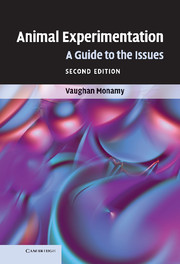Book contents
- Frontmatter
- Contents
- Preface to the second edition
- Acknowledgements
- 1 Issues in animal experimentation
- 2 A history of animal experimentation
- 3 Opposition to animal experimentation
- 4 The moral status of animals
- 5 Animal use
- 6 The regulation of experiments
- 7 Seeking alternatives
- 8 Conclusions
- Ethical guidelines for students in laboratory classes involving the use of animals or animal tissues
- References
- Index
2 - A history of animal experimentation
Published online by Cambridge University Press: 05 June 2012
- Frontmatter
- Contents
- Preface to the second edition
- Acknowledgements
- 1 Issues in animal experimentation
- 2 A history of animal experimentation
- 3 Opposition to animal experimentation
- 4 The moral status of animals
- 5 Animal use
- 6 The regulation of experiments
- 7 Seeking alternatives
- 8 Conclusions
- Ethical guidelines for students in laboratory classes involving the use of animals or animal tissues
- References
- Index
Summary
Those who think that science is ethically neutral confuse the findings of science, which are, with the activity of science, which is not.
Jacob Bronowski (1956, pp. 63–4)THE ORIGINS OF VIVISECTION IN EUROPE
Early records of vivisection procedures provide sobering reading. However, it is worthwhile to examine some of them in order to understand how public concern over animal experimentation arose. We need also to consider the origins of western scientific practices and the prevailing societal attitudes towards them. Readers interested in a complete history of animal experimentation and further insight into the historically important attitudes of humans towards animals are referred to excellent discussions elsewhere (Maehle and Tröhler 1987; Rupke 1987; French 1999; Ryder 2000).
Live animals, both human and non-human, appear to have been first used in ancient times, principally to satisfy anatomical curiosity. In the third century BC, the Alexandrian physicians Herophilus and Erisistratus are recorded as having examined functional differences between sensory nerves, motor nerves and tendons (Singer 1957). Galen of Pergamum (AD 129–199), a Greek physician working in Rome, catalogued these early experiments, as well as conducting his own. He described, for the first time, the complexities of the cardiopulmonary system, and speculated on brain and spinal cord function (Duckworth, Lyons and Towers 1962).
- Type
- Chapter
- Information
- Animal ExperimentationA Guide to the Issues, pp. 8 - 14Publisher: Cambridge University PressPrint publication year: 2009



